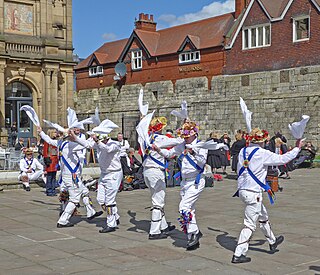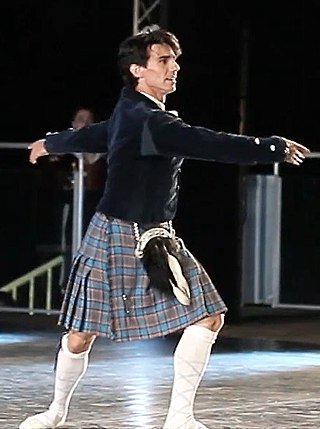
The pavane is a slow processional dance common in Europe during the 16th century (Renaissance).

Romeo and Juliet is a tragedy written by William Shakespeare early in his career about the romance between two Italian youths from feuding families. It was among Shakespeare's most popular plays during his lifetime and, along with Hamlet, is one of his most frequently performed. Today, the title characters are regarded as archetypal young lovers.
Overture is a music instrumental introduction to a ballet, opera, or oratorio in the 17th century. During the early Romantic era, composers such as Beethoven and Mendelssohn composed overtures which were independent, self-existing, instrumental, programmatic works that foreshadowed genres such as the symphonic poem. These were "at first undoubtedly intended to be played at the head of a programme".

Morris dancing is a form of English folk dance. It is based on rhythmic stepping and the execution of choreographed figures by a group of dancers in costume, usually wearing bell pads on their shins and/or shoes. A band or single musician, also costumed, will accompany them. Sticks, swords, handkerchiefs, and a variety of other implements may be wielded by the dancers.

Matteo Bandello was an Italian writer, soldier, Dominican friar and bishop, known mostly for his novellas. His collection of 214 novellas made him the most popular short-story writer of his day.
Moroccan music varies greatly between geographic regions and social groups. It is influenced by musical styles including Arab, Berber, Andalusi, Mediterranean, Saharan, West African, and others.

In Italy, music has traditionally been one of the cultural markers of Italian national and ethnic identity and holds an important position in society and in politics. Italian music innovation – in musical scale, harmony, notation, and theatre – enabled the development of opera, in the late 16th century, and much of modern European classical music – such as the symphony and concerto – ranges across a broad spectrum of opera and instrumental classical music and popular music drawn from both native and imported sources.

Romeo and Juliet, Op. 64, is a ballet by Sergei Prokofiev based on William Shakespeare's play Romeo and Juliet. First composed in 1935, it was substantially revised for its Soviet premiere in early 1940. Prokofiev made from the ballet three orchestral suites and a suite for solo piano.

The saltarello is a musical dance originally from Italy. The first mention of it is in Add MS 29987, a late-fourteenth- or early fifteenth-century manuscript of Tuscan origin, now in the British Library. It was usually played in a fast triple meter and is named for its peculiar leaping step, after the Italian verb saltare. This characteristic is also the basis of the German name Hoppertanz or Hupfertanz ; other names include the French pas de Brabant and the Spanish alta or alta danza.

Joaquín De Luz is a Spanish ballet dancer. He was formerly with the American Ballet Theatre (ABT), and a principal dancer with the New York City Ballet (NYCB). He is currently director of Spanish National Dance Company.
The weapon dance employs weapons—or stylized versions of weapons—traditionally used in combat in order to simulate, recall, or reenact combat or the moves of combat in the form of dance, usually for some ceremonial purpose. Such dancing is quite common to folk ritual on many parts of the world. Weapon dancing is certainly ancient; among the earliest historical references we have are those that refer to the pyrrhichios, a weapon dance in ancient Sparta, in which the dance was used as a kind of ritual training for battle.

Blackamoor is a type of figure/visual trope in European decorative art, typically found in works from the Early Modern period, depicting a man of sub-Saharan African descent, usually in clothing that suggests high status. Common examples of items and objects decorated in the blackamoor style include sculpture, jewellery, and furniture. Typically the sculpted figures carried something, such as candles or a tray. They were thus an exotic and lightweight variant for the "atlas" in architecture and decorative arts, especially popular in the Rococo period.

A Village Romeo and Juliet is an opera by Frederick Delius, the fourth of his six operas. The composer himself, with his wife Jelka, wrote the English-language libretto based on the short story "Romeo und Julia auf dem Dorfe" by the Swiss author Gottfried Keller. The first performance was at the Komische Oper Berlin on 21 February 1907, as Romeo und Julia auf dem Dorfe. Thomas Beecham conducted the British premiere at the Royal Opera House, Covent Garden in London on 22 February 1910. The US premiere was on 26 April 1972 in Washington, D.C.
Piva is an Italian Renaissance dance that may have originated from a peasant dance to the accompaniment of bagpipes. In 15th-century sources it is described as the fastest version of the basse danse. Antonio Cornazzano, for example, in his Libro del'arte del danzare, explains that the music for the piva was also called cacciata, was in quadruple time beginning on the downbeat and was twice as fast as music for the basse danse. The term appeared also in the 16th century, applied to compositions for lute. The pivas in Joan Ambrosio Dalza's 1508 lute collection are very repetitive pieces in quick triple time, with no clearly defined structure. However, it may not be accurate to describe them as being in triple time, since the fast triple rhythmic groupings do not represent one bar each, but rather single beats divided into triplets, just like Thoinot Arbeau's mesure ternaire for the basse danse.

Moresque is an obsolete alternative term to "Moorish" in English, and in the arts has some specific meanings. By itself, the word is used to describe the stylized plant-based forms of tendrils and leaves found in ornament and decoration in the applied arts in Renaissance Europe that are derived from the arabesque patterns of Islamic ornament. Like their Islamic ancestors, they differ from the typical European plant scroll in being many-branched and spreading rather than forming a line in one direction. The use of half-leaves with their longest side running along the stem is typical for both.

Baroque music refers to the period or dominant style of Western classical music composed from about 1600 to 1750. The Baroque style followed the Renaissance period, and was followed in turn by the Classical period after a short transition. The Baroque period is divided into three major phases: early, middle, and late. Overlapping in time, they are conventionally dated from 1580 to 1650, from 1630 to 1700, and from 1680 to 1750. Baroque music forms a major portion of the "classical music" canon, and is widely studied, performed, and listened to. The term "baroque" comes from the Portuguese word barroco, meaning "misshapen pearl". The works of George Frideric Handel and Johann Sebastian Bach are considered the pinnacle of the Baroque period. Other key composers of the Baroque era include Claudio Monteverdi, Domenico Scarlatti, Alessandro Scarlatti, Alessandro Stradella, Tomaso Albinoni, Johann Pachelbel, Henry Purcell, Antonio Vivaldi, Georg Philipp Telemann, Jean-Baptiste Lully, Jean-Philippe Rameau, Marc-Antoine Charpentier, Arcangelo Corelli, François Couperin, Johann Hermann Schein, Heinrich Schütz, Samuel Scheidt, Dieterich Buxtehude, Gaspar Sanz, José de Nebra, Antonio Soler, Carlos Seixas and others.
Moresche is the plural of moresca, meaning Moorish thing, or Moorish girl in Italian. Both the singular and plural can refer to both a 15th~16th century dance genre or to a 15th~16th century song genre. This article concerns the genre of moresche, polyphonic "moorish" songs.
This is an alphabetical index of articles related to the Renaissance.
Alfred Rodrigues was a South African ballet dancer and choreographer. His works have been produced by ballet and opera companies in many countries of the world.

Kammermohr was a German-language term since the 18th century for a court servant of black skin colour, which had by that time long been a common feature in European courts.













